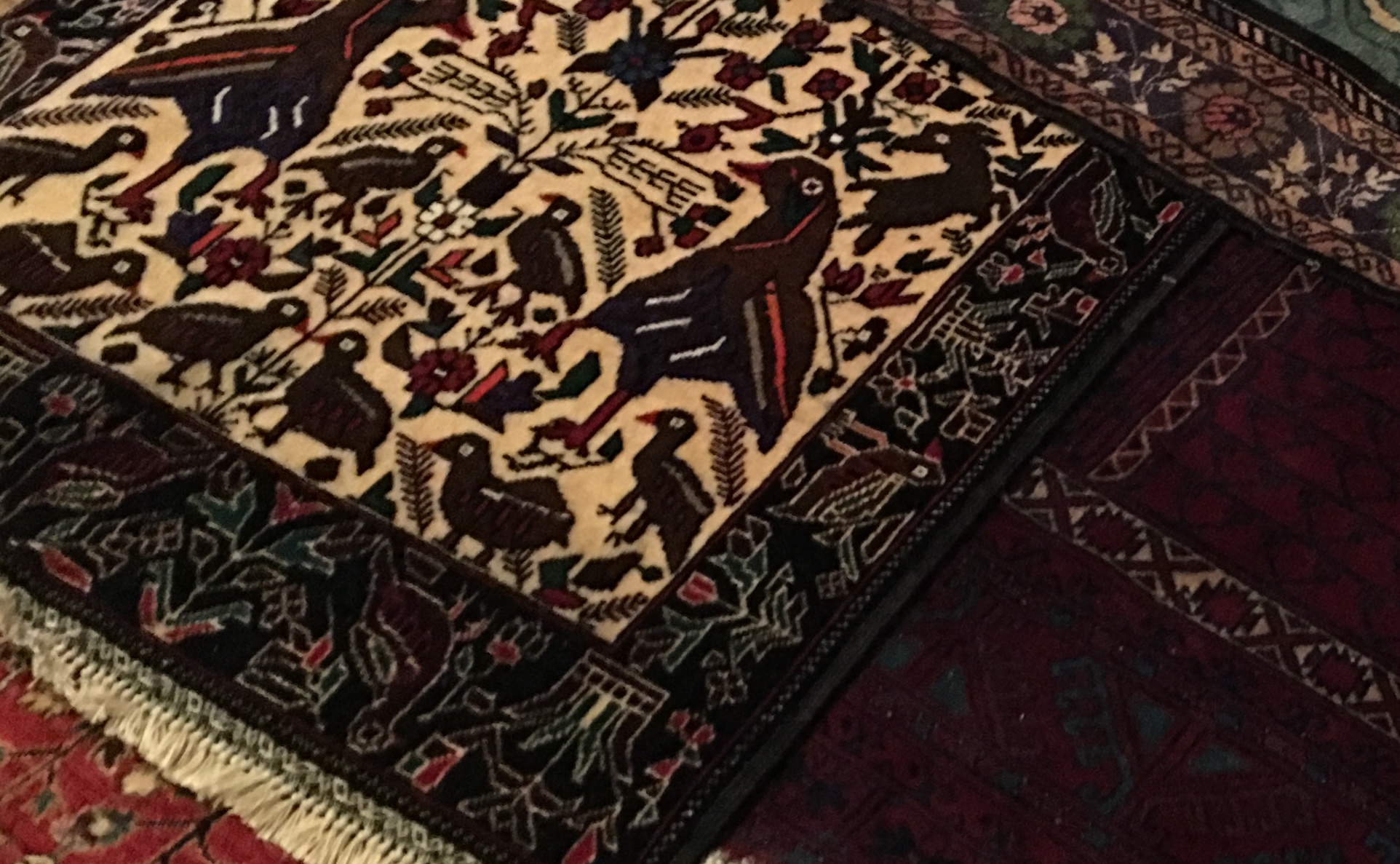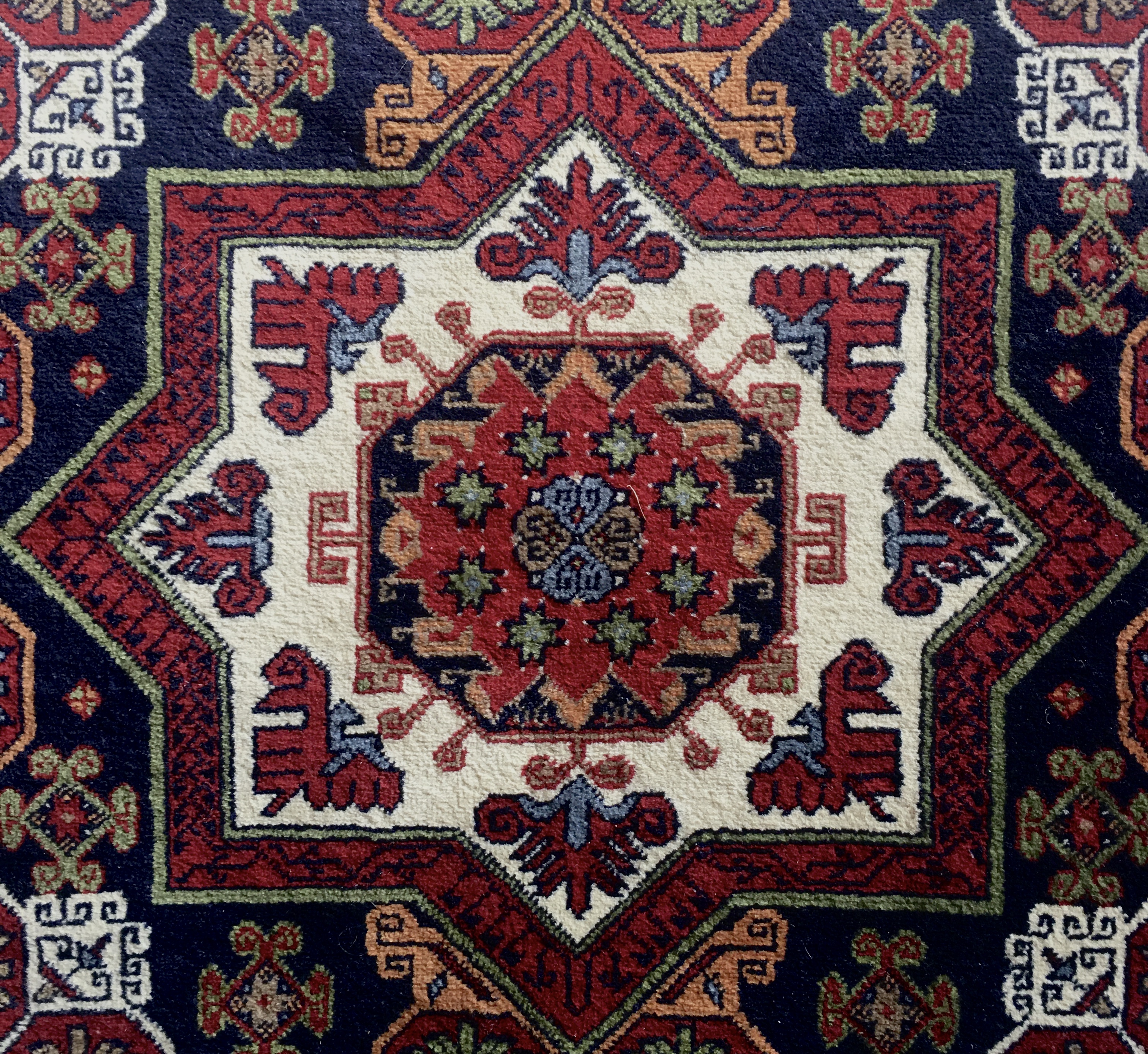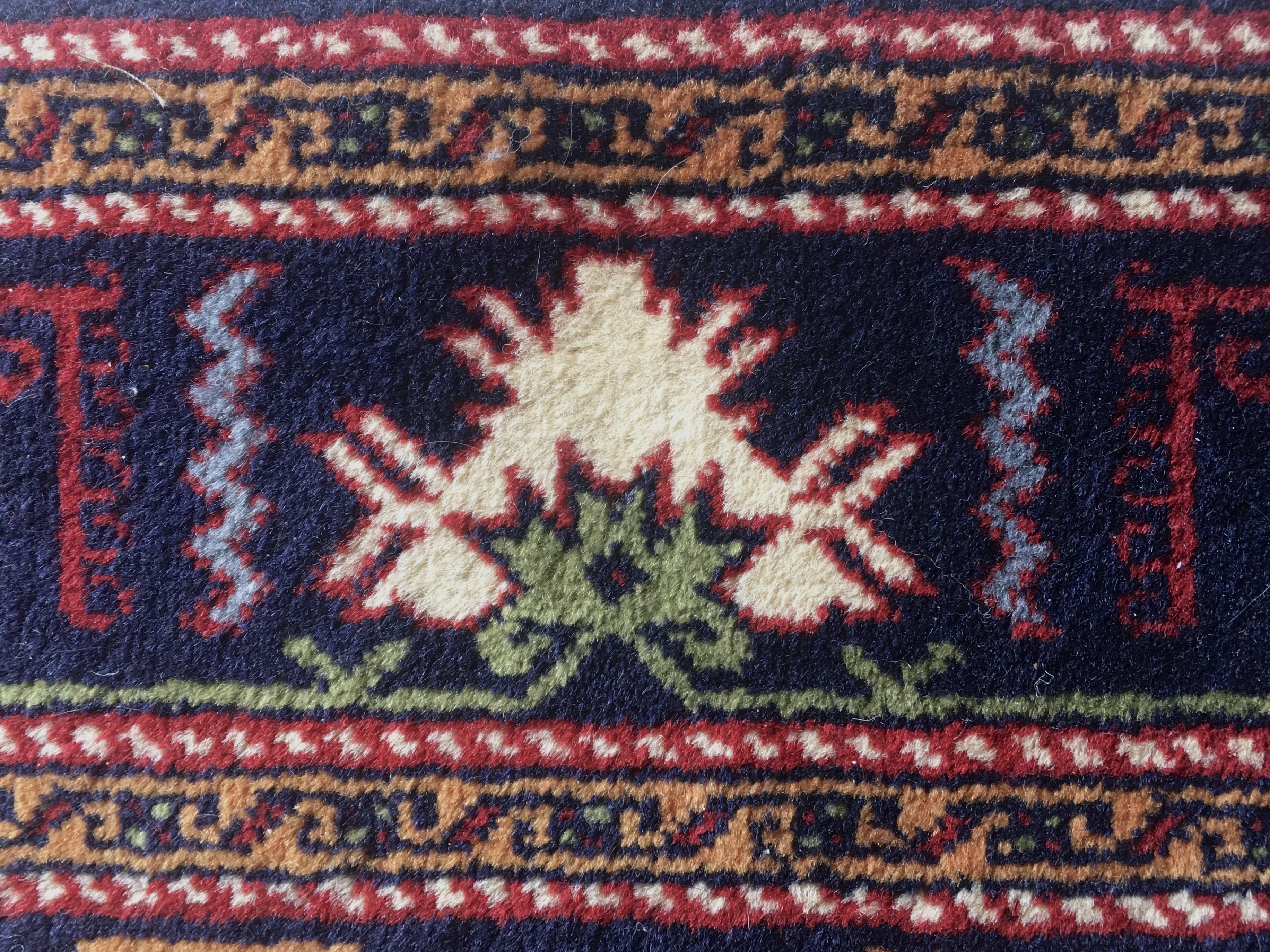
Check here for more information on the homepage rugs.
Nancy Small with Riyaz Bhat



Although any textile might be read as a text, this webtext focuses on handmade tribal rugs from Central Asia to lay out the method. Three factors motivate this choice: inaccessibility, talent, and beauty. Central Asian artisans, specifically nomadic and semi-nomadic women, live in places that are difficult if not impossible for most outsiders to visit. Tribal regions resist access due to extreme climates and often being situated within highly contested, war-torn territories. Norms and customs, as well as rightful skepticism of foreigners, reinforce privacy of home spaces where the rugs are woven. Some of the textiles produced by tribal weavers are decades, if not centuries, old. Time and space as well as lack of opportunities for intercultural learning separate us and limit how we can understand different ways of being in the world. Listening to the stories a tribal rug tells offers opportunities to mend these gaps.
A rug, as a handmade textile, is a composition: made up of content (fiber), organized (woven or knotted) around a central purpose or assertion (design), stylized (color, symbols), and generated for a particular audience and purpose, during a particular time (kairos, exigency). Rug weaving requires a complicated assemblage of "digital" technologies (Haas, 2007), from preparation, spinning, and plying of wool to locating plant resources to formulate natural dyes to building the loom to designing and color matching to warping, weaving, and binding off. The "layered literacies" (Cargile Cook, 2002) required for even a simple rug production are daunting.
Because of the artisanal expertise required in their creation, Central Asian tribal rugs are highly valued forms of material culture, celebrated in museums and heavily catalogued as commodities fetching from hundreds to tens of thousands of dollars or more in markets and auctions. Some of these textiles have been designed and composed by men, and those who demonstrate exceptional talent are celebrated as "master weavers" (Moheban, 2016). These men are exalted as the pinnacle of their artistic literacies in design, proportion, colorwork, and production: the rhetorical aspects of their craft.
In this universe of so-called Oriental rugs,[2] tribal women weavers have been designing and producing textiles of great beauty and skill throughout these same 25 centuries as men. However, despite attention granted to male masters of their craft, women weavers, when acknowledged at all, typically are portrayed in deficit terms. One of the earliest book-length treatments of tribal textiles is Mary Beach Langton's (1904) How to Know Oriental Rugs. In it, Langton lamented, "there is little enviable in the life of the Oriental woman; for while she seems content to toil at her loom . . . she is really a slave to the master of the house, and her life is one of joyless labor" (p. 29). Richard Parsons, a Brit who took up a career as carpet wholesaler in the mid–20th century, traveled extensively throughout Afghanistan, where many tribal families circulate. His book, The Carpets of Afghanistan, originally published in 1983, is now in its fourth edition. He told the following story:
When visiting a Turkoman compound for whatever reason, one is always accompanied by a male who will go ahead, knock loudly on the wooden door, warning the womenfolk of a stranger's advent. By the time that one is led inside, all the women will have disappeared from sight. However, it does happen that when examining a carpet still on the loom, one becomes aware of curious eyes peeping from behind a curtain. Good manners dictate that such mutual curiosity should be ignored. (Parsons, 2016, p. 23)
In this moment of intercultural interaction, the weavers are physically separated from their work, "disappeared" as artisanal agents and reduced to "curious eyes" via "good manners."
Brian Murphy (2005), a journalist smitten with the mysterious routes of the carpet trade, wrote about observing Turkoman girls working at their looms. Musing about presences and absences in the recording of history, he wrote, "Heroics and daring make good reading. But simplicity, dutiful repetition, and the safety of domestic spaces—the stuff often shunned by historians—are perhaps closer to the foundation on which everything rests and connects" (p. 74). Although framed clearly through the male, Western gaze, he is the only author, amidst a wide array of books examined for this project, to address the rhetorical nature of women weavers' work: "These girls, barely able to write their names, were adding to a historical record no less important than any political transcript. These carpets mean something, and the weavers are part of a vast and ancient sisterhood" (p. 74). At least for Murphy, the weavers' labor holds meaning.
Child brides, hidden possessions, slaves to the household, and exotic beings submissively toiling in private spaces: as agents and authors of their own material compositions, women weavers are diminished, ignored, or erased. The deficit, however, is ours if we do not make sufficient attempts to more fully listen to, recognize, and amplify the different technological, compositional, and cultural contributions implicit in their endeavors.
Seeking routes for tribal women weavers to (re)emerge into the public eye may seem an empowering move, but again, such an assumption results from Western values prioritizing individualism and gender egalitarianism. Tribal women may not want to participate in such spaces. Even if an individual weaver would enjoy being celebrated for her talents, her cultural and social contexts may make doing so a risky or impossible decision. In addition to spanning time and space, tribal rugs span cultures. How do we honor the talent and agency that go into creating tribal artifacts while still respecting and acknowledging the limitations of what we can and should know?
Reading a textile as a memoir of its maker is an act of "critical imagination" (Royster & Kirsch, 2012). It might transform our conceptions of, as well as empathy and admiration for, those who lives differ from our own, revealing them as complicated actors rather than voiceless objects. Such a reading puts agency back in the maker's hand, centering her as a talented artisan. By listening to the stories told through textile art, we can recognize (and re-cognize) evidence affirming and/or resisting other representations of the maker. When considering Central Asian rugs, that evidence resists Western-centric portrayals of tribal women as oppressed, uneducated, and lacking in agency. Through this method, material texts become openings to cross-cultural learning and invite complication of, resistance to, and revision of master narratives that harmfully overgeneralize the lives of Others.
This section reviewed the precarious location and common erasure of Central Asian women weavers despite the artisanship that goes into their rugs as material compositions. Gendered systems devalue their work, locking them out of the master weaver designation despite them having talents that merit study, appreciation, and amplification. To provide more background and context for the sample reading later in this webtext and to further demonstrate how market forces contribute to women's erasure, the next section, Selvages: Commodification of Tribal Rugs, reviews a selection of representative texts about tribal rugs, catalogued and celebrated as possessions even as their makers are rhetorically written out of existence.
[2] The terms rug and carpet are used interchangeably to indicate textiles that are woven and/or knotted on a loom, then used as floor coverings, wall coverings, doors, decorations, and other household functions (including as table spaces with diners sitting around the rug on the floor). The term Oriental, although commonly used to describe these textiles, is fraught, outdated, and vague, so I avoid it beyond this instance. Another designation, Islamic rugs, is troubling, too, because although it provides a homogenized reference for common religious beliefs and cultural patterns in tribal regions, the history and community identities—pre-Christian, Christian, Islamic—of these long inhabited spaces are more complex. Therefore, I prefer the terms tribal rugs and tribal carpets to foreground peoples and locations (home-based rather than commercial workshops). When referring to specific tribes and families (e.g., Baloch and Taimani), those names are provided.